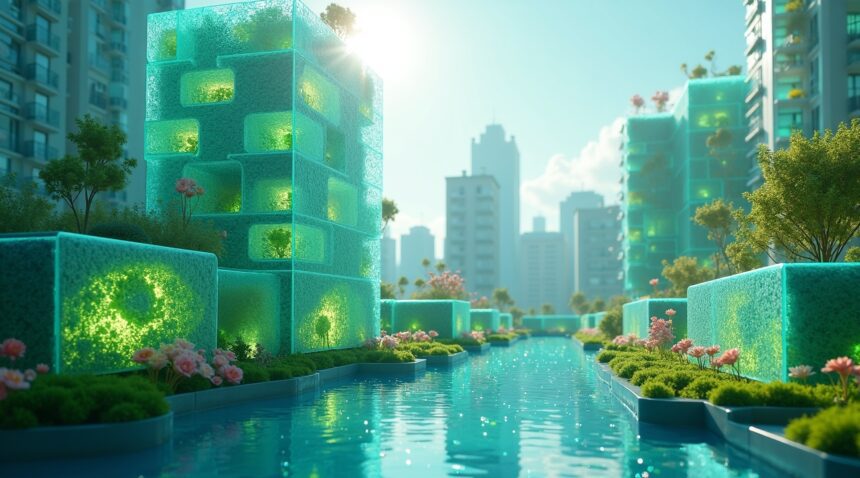Scientists at ETH Zurich have engineered a groundbreaking hydrogel containing living cyanobacteria that actively remove carbon dioxide from the atmosphere through photosynthesis.
Overview of the Breakthrough
This revolutionary hydrogel-bacteria system demonstrates exceptional longevity, maintaining its CO2 capture capabilities for over 400 days. Unlike previous biological methods, it converts most of the captured carbon into stable mineral forms, making it a more permanent carbon sequestration solution.
Key Takeaways
- CO2 Capture Capacity: The material continuously captured 26 ± 7 mg of CO2 per gram across 400 days, turning most captured carbon into mineral carbonates.
- Dual-Stage Mechanism: It uses photosynthesis for initial carbon capture, followed by precipitation of stable lime deposits for long-term storage.
- Architecture Integration: The technology can be 3D printed into complex building components, enabling carbon-negative infrastructure.
- Resource Efficiency: Matches or exceeds traditional carbon capture solutions using only sunlight, air, artificial seawater, and nutrients.
- Construction Revolution: Offers a sustainable alternative to high-emission materials like cement and steel.
How the Hydrogel System Works
The hydrogel matrix creates a protective and flexible environment for cyanobacteria, ideal for structural applications. These microorganisms continuously absorb atmospheric CO2 and convert it through natural photosynthesis processes.
Durability and Consistency
Testing confirmed the bacteria maintain high activity across more than a year, addressing a major drawback of traditional biological systems which often degrade over time.
Innovative Carbon Storage
After capturing CO2, bacteria first store carbon biologically. Then, the system precipitates calcium carbonate minerals, locking carbon away permanently. This reliable storage marks a major advance over purely biological capture methods.
Applications in Construction
Building with traditional materials like concrete emits significant greenhouse gases. This living hydrogel offers a transformative option—it actively removes atmospheric CO2 while serving as a structural material.
3D Printing Integration
Standard 3D printing equipment incorporates living bacteria into the hydrogel without harming them. This allows for customized shapes and structures suited to various architectural needs.
Optimizing Environmental Conditions
Performance thrives in natural sunlight, while temperature and humidity also influence bacterial efficiency. Indoor uses may require supplemental light, but even daylight through windows can significantly reduce CO2 levels.
Low Maintenance Advantage
In contrast with mechanical carbon capture, this system requires minimal upkeep. Bacteria reproduce independently within the hydrogel, needing only occasional nutrient input for sustained functionality.
Economic Viability and Scaling
Production costs are comparable to current carbon capture technologies, with lower operational expenses due to energy efficiency. Integrating hydrogel components into construction achieves both environmental and functional benefits in one material.
Production and Distribution Challenges
Scaling requires specialized facilities to maintain bacterial viability and sterilized environments. Effective transport and storage systems must also support living materials without degradation.
Future Development Goals
- Enhancing cyanobacteria strains for better CO2 uptake.
- Genetically increasing temperature tolerance and longevity.
- Exploring stronger hydrogel formulations for heavy-duty construction use.
The Road Ahead
This innovation marks a major leap in biological carbon capture. Combining reliable performance, structural utility, and scalable production, it presents a realistic path toward atmospheric CO2 reduction. If widely adopted, particularly in the construction sector, it could address climate change and material sustainability in a single solution.
Living Material Captures CO2 for Over a Year in Breakthrough Tests
Researchers at ETH Zurich have achieved a significant milestone in carbon capture technology by developing a revolutionary hydrogel material that houses living photosynthetic cyanobacteria. This innovative approach demonstrates remarkable longevity, with the material continuously removing carbon dioxide from the atmosphere for extended periods that challenge traditional expectations of biological systems.
The breakthrough centers on encapsulating cyanobacteria within a specially designed hydrogel matrix that protects these microscopic organisms while allowing them to perform photosynthesis. Laboratory testing revealed the material’s exceptional endurance, maintaining CO2 capture capabilities for up to 400 days of continuous operation. This extended operational period represents a substantial advancement in living material technology, proving that biological systems can maintain functionality far longer than previously demonstrated.
Quantified Carbon Sequestration Results
The research team documented impressive carbon capture metrics throughout their testing period. Key performance indicators include:
- Total CO2 sequestration reached 26 ± 7 mg per gram of material after 400 days of operation
- Short-term capture rates showed 2.5 mg CO2 per gram over 30-day periods
- Mineral carbonate formation accounted for 2.2 ± 0.9 mg per gram during the 30-day assessment
- Most captured carbon converted into stable mineral forms rather than remaining in biological tissues
The data reveals that the majority of sequestered carbon transforms into mineral carbonates, creating a more permanent storage solution than purely biological capture methods. This mineral formation process occurs naturally as the cyanobacteria process CO2 through photosynthesis, creating byproducts that crystallize within the hydrogel structure.
The photosynthetic activity of the encapsulated cyanobacteria remains remarkably stable throughout the testing period. Scientists confirmed that these organisms maintain their ability to convert carbon dioxide and sunlight into energy for more than a year, demonstrating exceptional resilience within their hydrogel environment. This sustained biological activity represents a critical factor for practical applications, as it eliminates the need for frequent material replacement or organism replenishment.
The hydrogel matrix serves multiple functions beyond simple containment. It provides nutrients to the cyanobacteria while protecting them from environmental stresses that typically limit bacterial lifespan. The material also facilitates gas exchange, allowing CO2 to reach the organisms while enabling oxygen release as a beneficial byproduct of the photosynthetic process.
This research builds upon growing interest in artificial intelligence applications in biotechnology, where computational models help optimize biological systems for environmental applications. The success of this project opens possibilities for scaling up production and implementing these materials in real-world carbon capture scenarios.
The implications extend beyond laboratory demonstrations. These findings suggest that living materials could serve as sustainable alternatives to energy-intensive industrial carbon capture technologies. Unlike mechanical systems that require constant energy input, these biological materials harness solar energy directly through photosynthesis, creating a self-sustaining carbon capture process.
Manufacturing considerations become crucial for widespread implementation. The hydrogel production process must maintain sterility while ensuring optimal cyanobacteria distribution throughout the material. Quality control measures need to verify bacterial viability and photosynthetic capacity before deployment.
Environmental applications could include integration into building materials, outdoor installations, or specialized carbon capture facilities. The material’s ability to function autonomously for extended periods makes it particularly attractive for remote locations where maintenance access is limited.
Cost analysis will determine commercial viability, comparing production expenses against carbon capture efficiency. The 400-day operational period significantly improves economic prospects by reducing replacement frequency and associated labor costs.
Future research directions include optimizing bacterial strains for enhanced CO2 processing, developing more efficient hydrogel formulations, and testing performance under various environmental conditions. Scientists continue exploring ways to increase capture rates while maintaining the impressive longevity already demonstrated.
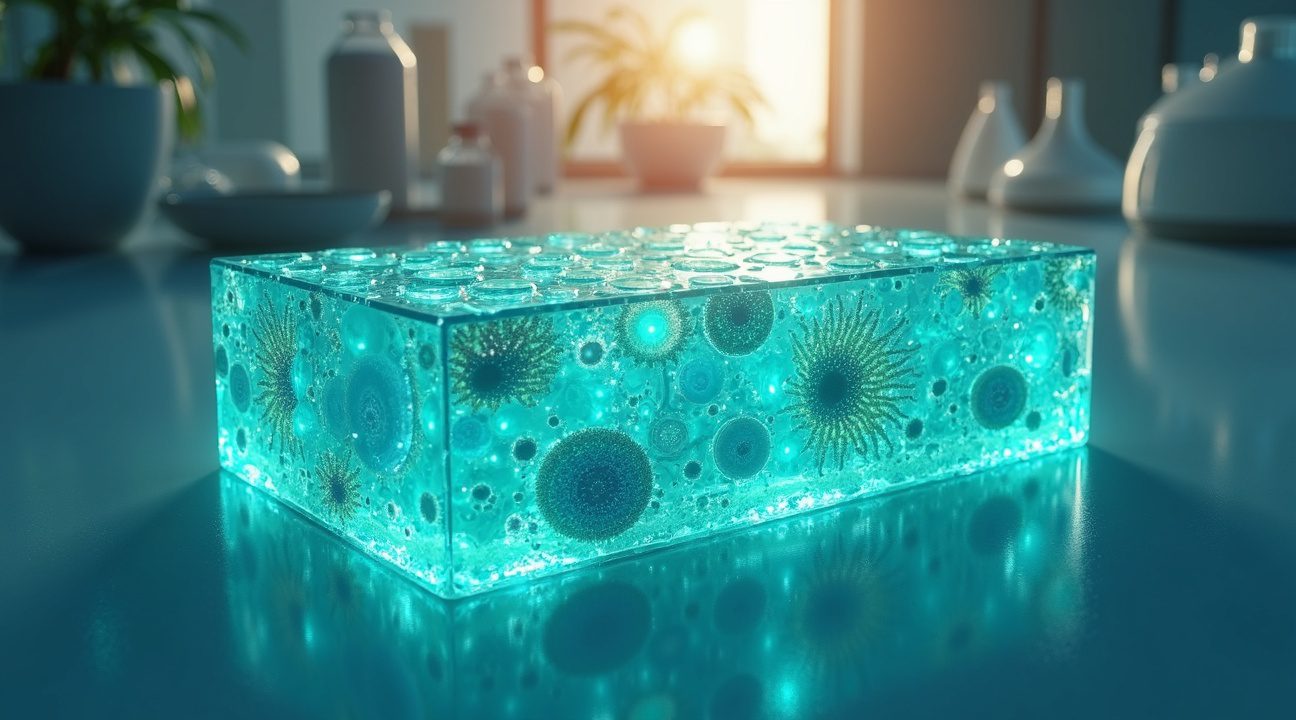
How the Dual Carbon Capture System Works
This revolutionary material operates through a two-pronged approach that transforms atmospheric carbon dioxide into both biological and mineral storage forms. The process combines natural photosynthetic mechanisms with induced mineralization, creating a comprehensive carbon capture solution that addresses multiple environmental challenges simultaneously.
The Twin Pathways of Carbon Storage
The system initiates carbon capture through traditional photosynthesis, where cyanobacteria absorb CO2 directly from the atmosphere and convert it into biomass. This biological pathway represents the first line of defense against atmospheric carbon accumulation. Following biomass creation, the bacteria’s metabolic activity triggers a secondary process that precipitates solid carbonates, including lime, which stores carbon in a mineral form that proves far more stable and long-lasting than organic biomass alone.
Scientists have developed this dual approach to maximize carbon storage efficiency while creating materials with practical applications. The mineral deposit formation occurs gradually within the material structure, automatically increasing its mechanical strength over time — a crucial feature for potential structural applications in construction and engineering.
The operational requirements remain surprisingly simple, requiring only:
- Sunlight
- Atmospheric CO2
- Artificial seawater
- Common nutrients
This minimal input requirement makes the system highly scalable and economically viable for widespread deployment. The bacteria essentially feed on the very pollutant they’re designed to eliminate, creating a self-sustaining cycle that continues as long as sunlight and CO2 remain available.
What sets this technology apart from other innovative solutions is its ability to create permanent carbon storage through mineral formation. While biomass can decompose and release stored carbon back into the atmosphere, the carbonate minerals formed through bacterial metabolism remain stable for extended periods, effectively removing CO2 from the carbon cycle indefinitely.
The mineralization process transforms dissolved carbon compounds into solid deposits that integrate seamlessly with the material structure. As these deposits accumulate, they create a progressively stronger composite material that could potentially replace traditional construction materials while actively removing carbon from the atmosphere. This unique combination of environmental benefit and practical utility positions the technology as a promising tool in comprehensive CO2 mitigation strategies.
The bacteria continue their dual function throughout the material’s operational life, constantly processing atmospheric CO2 through both pathways. This ongoing carbon processing capability means the material becomes increasingly effective over time, both as a carbon sink and as a structural component with enhanced mechanical properties.
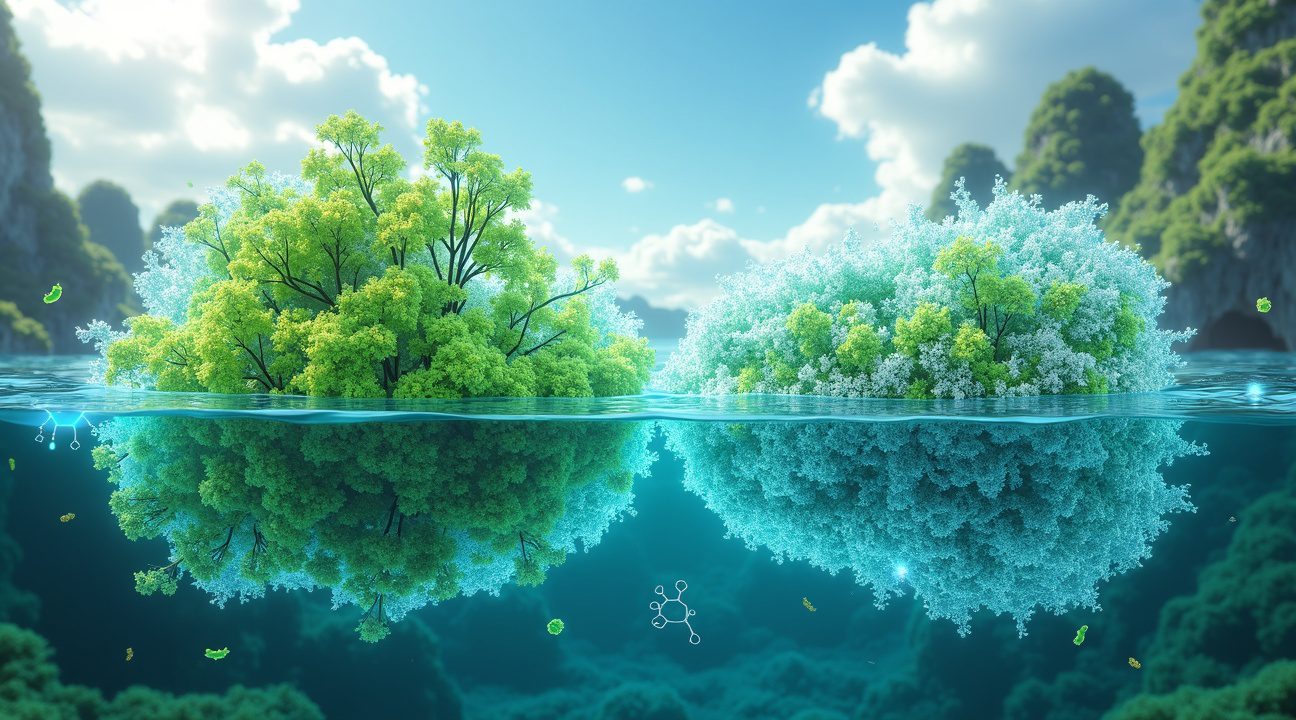
3D Printing Creates Carbon-Capturing Building Components
The hydrogel-cyanobacteria composite’s printable nature opens up remarkable possibilities for architectural innovation. I can shape this living material into complex geometries through direct ink writing and light-based additive manufacturing techniques. The material flows smoothly through printing nozzles while maintaining the viability of embedded bacteria, creating structures that function as biological carbon capture systems from the moment they’re constructed.
Advanced Manufacturing Techniques for Living Architecture
Direct ink writing allows architects and engineers to create intricate building components with precisely controlled porosity patterns. The printing process can incorporate multiple design strategies that optimize both structural integrity and biological function. Light-based additive manufacturing offers even greater precision, enabling the creation of microscale features that enhance the material’s carbon sequestration capabilities.
The printing parameters can be adjusted to create biomimetic porous structures that mirror cellular fluidics found in nature. These designs maximize surface area contact between the cyanobacteria and atmospheric carbon dioxide while ensuring optimal light penetration for photosynthesis. Complex internal channels and branching patterns distribute nutrients efficiently throughout the printed structure, maintaining bacterial health over extended periods.
Integration into Modern Construction Systems
Building components made from this living material can function as carbon-neutral infrastructure elements that actively remove CO2 from the atmosphere. Printed bricks maintain structural strength while hosting thriving bacterial colonies that continuously process carbon dioxide into biomass. Wall panels incorporate sophisticated pore networks that facilitate gas exchange while protecting the embedded microorganisms from environmental stresses.
Coating applications represent another promising avenue for deployment. Thin layers of the printable composite can be applied to existing building surfaces, transforming passive structures into active carbon capture systems. These coatings adapt to various substrate materials while maintaining their biological activity for months or years after application.
The material’s compatibility with conventional construction methods makes integration straightforward. Standard mounting hardware and connection systems work effectively with printed components. Installation procedures require minimal modification from traditional building practices, though proper orientation ensures optimal light exposure for continued photosynthetic activity.
Recent advances in artificial intelligence have enhanced the design optimization process for these living building materials. Machine learning algorithms can predict the most effective pore patterns and structural configurations for specific environmental conditions and carbon capture targets.
Quality control during the printing process ensures consistent performance across batches. Real-time monitoring of bacterial viability and printing parameters maintains the biological integrity of each component. Post-printing curing procedures can enhance both mechanical properties and biological stability without compromising the living aspects of the material.
The scalability of this printing approach makes it suitable for both small architectural details and large structural elements. Production facilities can manufacture components off-site under controlled conditions, then transport them to construction sites for installation. This approach maintains the biological activity of the cyanobacteria while providing the convenience of prefabricated building components.
Environmental monitoring systems can track the carbon capture performance of installed components over time. Sensors embedded within printed structures provide real-time data on CO2 processing rates and bacterial health indicators. This feedback enables building operators to optimize conditions for maximum carbon sequestration efficiency.
The economic benefits of carbon-capturing building materials become increasingly attractive as carbon credits and environmental regulations create market incentives for emissions reduction. Buildings constructed with these components could generate revenue through verified carbon capture while reducing overall construction environmental impact.
Maintenance requirements for living building components remain minimal compared to mechanical carbon capture systems. The self-sustaining nature of the bacterial colonies reduces operational costs while providing continuous atmospheric carbon processing. Regular assessments ensure optimal performance, but the biological systems largely maintain themselves through natural metabolic processes.
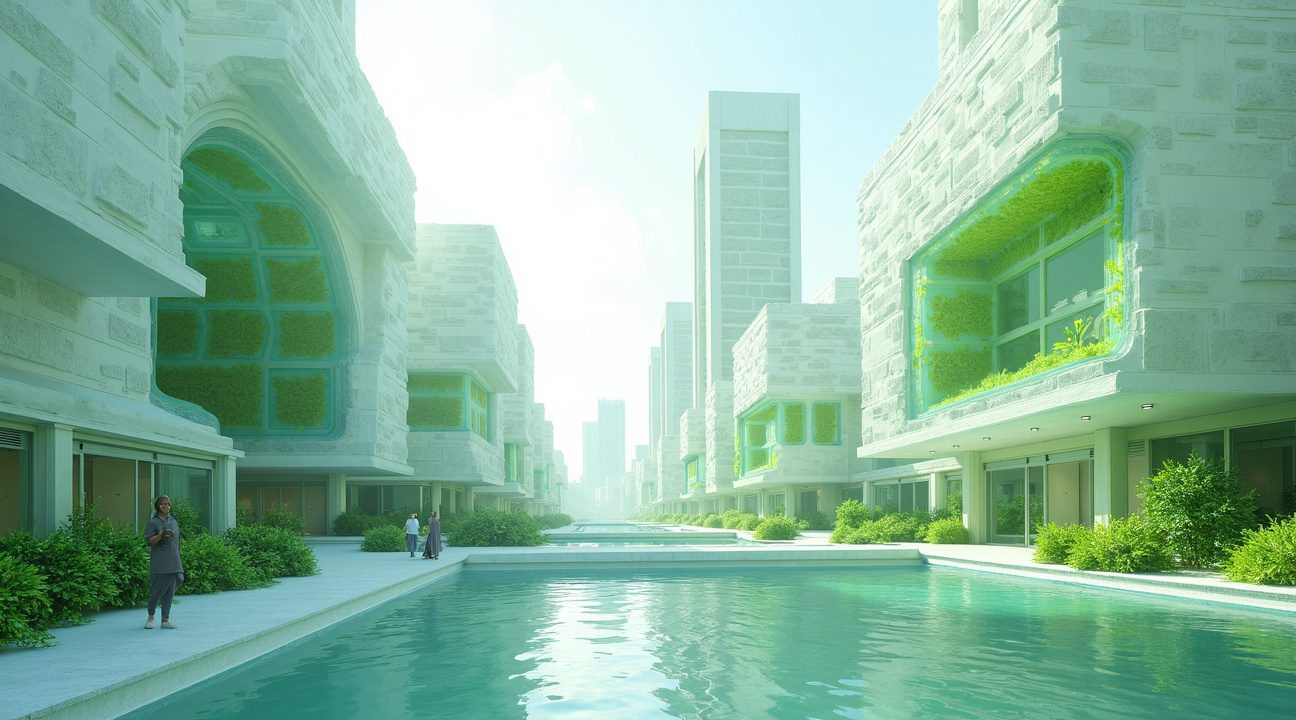
Performance Rivals Traditional Carbon Capture Methods
The bacterial photosynthetic material demonstrates impressive carbon capture capabilities that match or exceed established industrial methods. When compared to chemical mineralization approaches like recycled concrete, which typically achieves about 7 mg CO2 per gram, this living system shows remarkable potential for large-scale carbon sequestration applications.
Superior Carbon Sequestration Rates
Laboratory testing reveals that the living material achieves maximum sequestration rates of 26 ± 7 mg CO2 per gram of material, with the majority stored as stable minerals. This performance significantly outperforms many conventional carbon capture technologies currently in use. Over a 30-day period, the material consistently sequesters 2.5 mg CO2 per gram, with 2.2 ± 0.9 mg per gram converted into permanent mineral forms that won’t release back into the atmosphere.
The conversion to mineral carbonates represents a crucial advantage over other carbon capture methods that simply store CO2 in pressurized containers or underground formations. These mineral forms provide long-term stability without requiring ongoing energy inputs to maintain storage integrity. The bacterial system essentially creates its own permanent carbon storage solution through natural biological processes.
Long-Term Operational Sustainability
Perhaps most impressive is the material’s ability to maintain continuous sequestration for up to 400 days without significant performance degradation. This extended operational lifespan reduces replacement costs and maintenance requirements compared to synthetic alternatives that often require frequent regeneration or replacement cycles. The longevity stems from the self-sustaining nature of the bacterial colonies, which continue photosynthetic activity as long as basic environmental conditions are met.
Maintenance requirements remain refreshingly simple, supporting widespread adoption across various industrial applications. Unlike complex chemical capture systems that demand specialized technicians and expensive reagents, this living material requires only basic environmental controls for light, moisture, and nutrients. The straightforward operational demands make the technology accessible to smaller facilities and developing regions where sophisticated infrastructure might be limited.
The system’s resilience also extends to varying environmental conditions, allowing deployment in diverse settings without extensive modifications. This adaptability opens possibilities for applications ranging from urban air purification to industrial emission control, where artificial intelligence systems could optimize performance parameters automatically.
Research teams continue studying the material’s performance across different temperature ranges and humidity levels to fully understand its operational boundaries. Early results suggest the bacterial system maintains effectiveness across typical ambient conditions found in most industrial settings, eliminating the need for costly climate control systems that burden other carbon capture technologies.
The combination of high capture rates, mineral storage stability, and minimal maintenance requirements positions this living material as a competitive alternative to existing carbon capture solutions. While traditional methods often struggle with energy consumption and operational complexity, the bacterial approach leverages natural processes that have evolved over billions of years to efficiently process atmospheric carbon.
Scientists are now exploring optimization strategies to enhance capture rates further while maintaining the system’s inherent simplicity. These efforts focus on bacterial strain selection and environmental condition fine-tuning rather than complex engineering modifications. The biological foundation provides a flexible platform for improvements that don’t require complete system redesigns.
Implementation across various scales appears feasible, from small commercial buildings to large industrial facilities. The modular nature of bacterial colonies allows systems to be sized appropriately for specific applications without losing efficiency. This scalability advantage could accelerate adoption timelines compared to other carbon capture technologies that require substantial infrastructure investments to achieve economic viability.
Revolutionary Impact on Construction Industry’s Carbon Footprint
The construction industry stands as one of the world’s largest carbon polluters, with conventional building materials like cement, steel, and plastic releasing massive quantities of CO2 during production and use. Cement production alone accounts for approximately 8% of global carbon emissions, while steel manufacturing contributes another significant portion to our planet’s greenhouse gas burden.
These bacterial-engineered living materials present a game-changing alternative that flips the script entirely. Instead of adding to atmospheric carbon, these innovative materials actively consume CO2 while performing their structural functions. The bacteria within these materials continuously photosynthesize, pulling carbon dioxide from the air and converting it into useful biomass, essentially turning buildings into carbon-capturing machines.
Transforming Infrastructure Development
The potential applications span across multiple sectors, fundamentally altering how we approach construction projects:
- Green building initiatives can now incorporate materials that literally clean the air around them
- Architectural designs can feature living walls and surfaces that actively reduce atmospheric carbon
- Civil engineering projects like bridges and roadways could become carbon-negative installations
- Urban infrastructure development can contribute to climate solutions rather than climate problems
The scalability aspect is particularly compelling because the bacterial systems require minimal external inputs once established. Unlike complex carbon capture technologies that demand significant energy and maintenance, these living materials operate through natural photosynthetic processes. The bacteria reproduce and maintain themselves, creating a self-sustaining system that continues functioning throughout the material’s lifespan.
The simplicity of implementation makes widespread adoption feasible across different economic conditions and geographical locations. Construction teams won’t need specialized training to work with these materials, and the production processes can be adapted to existing manufacturing infrastructure. This accessibility factor could accelerate global adoption and maximize the environmental impact.
Early research suggests that buildings constructed with these materials could achieve carbon-negative status over their operational lifetime. The continuous CO2 absorption potentially outweighs the initial carbon costs of construction, manufacturing, and transportation. This represents a fundamental shift from damage mitigation to active environmental restoration through our built environment.
Current projections indicate that widespread implementation could dramatically reduce the construction industry’s carbon footprint within decades. The technology offers a practical solution that addresses both immediate building needs and long-term climate goals simultaneously. Each structure becomes a contributor to atmospheric carbon reduction rather than a source of ongoing emissions.
The economic implications extend beyond environmental benefits, as carbon credits and green building certifications could provide additional revenue streams for projects utilizing these materials. I anticipate that regulatory frameworks will evolve to incentivize adoption, potentially making traditional high-emission materials less competitive in the marketplace.
Manufacturing scalability appears promising because bacteria reproduce rapidly under controlled conditions, and the production process doesn’t require rare materials or extreme processing conditions. This biological approach to material science could establish new industry standards where buildings actively participate in climate change mitigation rather than simply minimizing their negative impact.
The transformation extends beyond individual buildings to entire urban ecosystems. Cities constructed with these materials could function as large-scale carbon sinks, fundamentally changing how we view urban development’s environmental role. This technology bridges the gap between human infrastructure needs and planetary health requirements, offering a path where development enhances rather than degrades environmental conditions.
Scientists continue refining the bacterial strains and material compositions to optimize both structural performance and carbon capture efficiency. The convergence of biotechnology and construction materials science opens possibilities for artificial intelligence applications in optimizing these systems for specific environmental conditions and building requirements.

Future Research and Optimization Opportunities
Scientists continue developing this breakthrough technology through several promising research avenues. The current focus centers on establishing precise quantitative measurements of photosynthetic rates and oxygen evolution to maximize the material’s efficiency. These measurements will enable researchers to fine-tune the bacterial composition and environmental conditions for optimal carbon dioxide consumption.
Enhanced Carbon Sequestration Development
Research teams are working to strengthen the dual carbon sequestration mechanisms that make these living materials so effective. By improving both the biological and chemical pathways that capture carbon dioxide, scientists aim to create materials with significantly higher absorption rates. This enhancement could transform how industries approach carbon neutrality goals, similar to how artificial intelligence is revolutionizing other technological fields.
The optimization process involves adjusting bacterial strain combinations and nutrient delivery systems to maintain peak photosynthetic activity over extended periods. Scientists are also exploring genetic modifications that could boost the bacteria’s natural carbon-processing capabilities without compromising the material’s structural integrity.
Expanding Application Possibilities
Beyond construction applications, researchers are investigating how these photosynthetic materials could revolutionize multiple industries. The technology shows promise for:
- Automotive manufacturing for self-healing, carbon-absorbing vehicle components
- Aerospace applications where lightweight, oxygen-producing materials could benefit space exploration
- Textile production for clothing that actively cleans the air
- Electronics manufacturing for eco-friendly device casings that offset carbon emissions
- Agricultural infrastructure that enhances crop growth while reducing atmospheric carbon
Studies on long-term performance and durability remain critical for widespread adoption. Scientists must understand how these living materials behave under various environmental stresses, temperature fluctuations, and moisture conditions. This research parallels other scientific breakthroughs where long-term stability proves essential, much like how researchers study complex brain phenomena over extended periods.
Current testing protocols examine material degradation rates, bacterial viability over time, and photosynthetic efficiency decline. These assessments help determine maintenance requirements and replacement schedules for real-world applications. Scientists are also developing protective coatings and support systems that could extend the materials’ operational lifespan while maintaining their carbon-absorbing properties.
The research timeline suggests commercial applications could emerge within the next decade, contingent on successful optimization of these key performance factors. Each advancement brings this revolutionary technology closer to transforming how humanity addresses climate change through innovative material science.
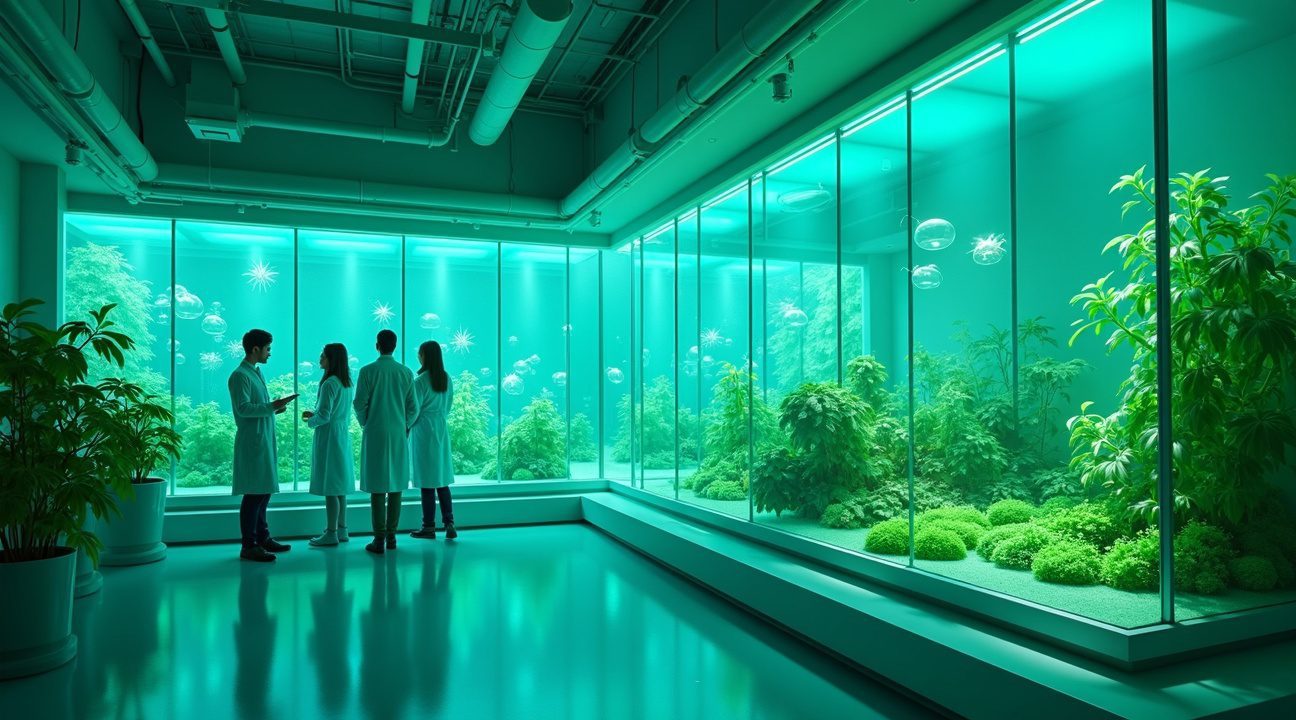
Sources:
SciTechDaily: “New Material Removes CO₂ From Air Like a Tree”
ETH Zurich: “A building material that lives and stores carbon”
Nature: “Dual carbon sequestration with photosynthetic living materials”
ScienceDaily: “Scientists create living building material that captures CO₂ from the air, twice over”
PMC: “Dual carbon sequestration with photosynthetic living materials”
Futurity: “Living building material sucks CO₂ out of the air”
Anthropocene Magazine: “These building materials are alive, photosynthetic— and carbon capturing”

